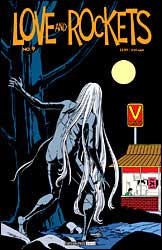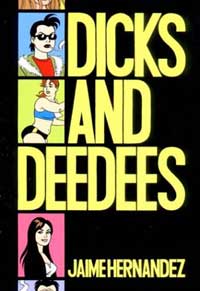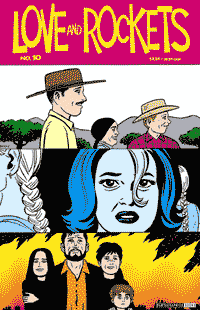- Comics
- Comics Reviews
- Manga
- Comics Reviews
- European Comics
- News
- Comics News
- Press Releases
- Columns
- Spotlight
- Digital Comics
- Webcomics
- Cult Favorite
- Back Issues
- Webcomics
- Movies
- Toys
- Store
- More
- About
By LJ Douresseau
February 23, 2004 - 10:59

 It's hard to believe, but for almost a quarter of a century, Jaime Hernandez and his brother Gilbert Hernandez (along with occasional appearances from Mario Hernandez) have drawn their beloved comic series, LOVE AND ROCKETS. A magazine-sized L&R lasted from the early 80's to the mid 90's (50 issues) before Jamie and Gilbert decided to part ways and have their own individual comics - Jaime's PENNY CENTURY and Gilbert's LUBA. However, by 2000, they and their publisher Fantagraphics Books had to give up that experiment due to disinterest on the part of comic shops and to buyers who preferred the brothers share a comic.
It's hard to believe, but for almost a quarter of a century, Jaime Hernandez and his brother Gilbert Hernandez (along with occasional appearances from Mario Hernandez) have drawn their beloved comic series, LOVE AND ROCKETS. A magazine-sized L&R lasted from the early 80's to the mid 90's (50 issues) before Jamie and Gilbert decided to part ways and have their own individual comics - Jaime's PENNY CENTURY and Gilbert's LUBA. However, by 2000, they and their publisher Fantagraphics Books had to give up that experiment due to disinterest on the part of comic shops and to buyers who preferred the brothers share a comic.
In 2001, LOVE AND ROCKETS, VOL. 2 appeared, and in the time since, Jaime's storytelling abilities continue to mature. For a long time, people focused on his art. Indeed, no American artist in recent decades has so mastered black and white comics storytelling (using black and white as a choice) as he has. There is a literal gap between what Alex Toth (another master of B&W comics) did decades ago and what Jaime has been doing for years, especially since 2001. Now, his writing has caught with the gorgeous art.
Fantagraphics has been publishing THE COMPLETE LOVE AND ROCKETS since the 80's, a venture to publish all of the Brothers Hernandez L&R related comics in book form. I recommend all of them, but especially the 2003 volume, DICKS AND DEEDEES (ISBN: 1-56097-540-7, $18.95), a Jaime hardcover collection that can serve as a jump on point for new readers.
When I began this interview last year, we were awaiting the publication of L&R #9, but as we finished this, we're just weeks away from the double-sized #10. Issue ten will see the end of the serial, "Maggie," that has been running since L&R Vol. 2 #1 and focused on Maggie Chascarrillos, one half of Jaime's famous comic duo, Maggie & Hopey. This is, I hope, the first of many visits with Jaime:
What's scheduled to be on the shelves in the next few months?
XAIME: Love & Rockets volume II # 9
In your interview with the Suicide Girls website, you said that still have ideas left - in reference to how long LOVE AND ROCKETS has been around. Is L&R V.2 going to be your only vehicle for expressing your ideas or will you look for other ways to express yourself, such as PENNY CENTURY?
XAIME: Right now L&R is the only place I have time for. I would only do the same material in Penny Century and other books, anyway.
Most of your creative endeavors have been centered on L&R. What are the reasons you've stayed close to that book, if you feel like discussing it?
XAIME: Because of the freedom L&R allows me. I can do anything I want in L&R and always have. Even if I want to do a dumb superhero story it would go in there because it would be done on my terms. The only rule I've given myself in this book is that the material must communicate with the reader whether it is in the tiniest way or the broadest way.
It does seem as if the countless articles about L&R have not translated into huge sales. Are you considering or have you considered doing something like Warren Ellis or Grant Morrison where you basically push yourself or the book as a brand name?
XAIME: I don't know what that means.
Let me approach this the long-winded way. More comic book writers are coming to realize that they can push their names over the books they producing, similar to what people do in novels and film. For instance, many people will buy a Tom Clancy novel not necessarily because the book is good on its own merits, but because it's a "Tom Clancy novel." Is THE LAST SAMURAI a moving starring Tom Cruise or is it a "Tom Cruise movie?"
So a comic book isn't just a book written by Warren Ellis, it's a Warren Ellis book. A group of buyers will buy it automatically buy it because it's a Warren Ellis comic and they associate Ellis' name with a pleasurable comic book experience. So my question is have you considered doing the kind of flashy, mainstream work that might make you a better known name? As an example, after you drew a hot overpriced Spider-Man comic, people started to look for any "Jaime Hernandez book."
XAIME: I don't know if I would be so proud to splash my name in large letters for doing a Spider-Man comic in the first place. Don't get me wrong, I would love to have readers from all corners of comicdom but I would really much rather expose them to my personal work. Also, I'm not so sure my name is bigger than "Love and Rockets" anyway, which is fine with me because it's half mine anyway. I guess I'm not that desperate for fans.
Or [have you thought about] doing lots of self-promotion? Have you thought about "jaime.com?"
XAIME: Nah, I've never been the type.
Did Fantagraphics' financial problems last year concern you?
XAIME: Yes and no. I guess I'm an optimist.
I'm not trying to get up in your private business with Fantagrahics, but I'm asking if at any point you felt vulnerable and felt deep concern about L&R having to find a new publisher?
XAIME: Yes, but I don't know of any other publisher that would let us do it the way we do it.
 I want more people to share the pure joy you and your brother's work gives me. Would you mind briefly describing your part of Love and Rockets for potential new readers?
I want more people to share the pure joy you and your brother's work gives me. Would you mind briefly describing your part of Love and Rockets for potential new readers?
XAIME: Oh, I dunno. It takes too long.
OK. Granted that sometimes readers don't seem to have a clue as to what really defines an author's work or at least readers and the author don't often agree, I'm going to try to define Love and Rockets. In volume one of the series, your half of the book was about a group of young Mexican-Americans who lived in the fictional neighborhood/town of Hoppers (California?). Your Hoppers stories featured an ensemble cast of youth immersed in the (L.A.) punk scene, but the predominant players where Maggie and Hopey. Volume 2 of the new series (2001) features many of the same players, but now Maggie seems to be the focus. Love and Rockets is no longer about a group of Hispanic punk rockers. It's now the story of young woman who has lost her way. Not only is her life in a rut, she's become the supporting character in her own life, watching everyone go on with their craziness while she stands still. Is that an adequate description of L&R, Vol. 2 as it stands with issue nine?
XAIME: Yes, but this current Maggie storyline ends in issue ten. After that I'll be focusing on some other characters with Maggie as an occasional supporting character, so it's still basically a "Locas" book, I guess.
From the beginning of L&R, it was clear that you and your brothers had a unique vision and process by which you were going to tell stories. I know music played a part in your development as a storyteller, but were there comic books and/or prose works to which you looked for inspiration - things that you may have copied or to which you looked for inspiration?
XAIME: It's really hard for me to say what exact material I "borrowed" for my work because the way I work is very organic and I rarely think about what I'm putting down till the work is finished. If somebody tells me a particular drawing I did looks very much like another artist, I seldom deny it because I probably meant it to be unconsciously. So, I guess every comic book, movie, TV show, wrestling match, life experience, etc... that I absorbed up to that point was what inspired my own comics. Characterization was probably the most valuable element I absorbed from all that stuff.
Are there today works of fiction or non-fiction that continue to influence what you do, things off of which you can riff, so to speak. Or is creating Locas right now pretty much a solitary experience in which you're just going by what's in your head?
XAIME: At this point there are fewer pieces of work that inspire me, partly because over the years my Locas world has become so vast in my brain that it writes its own history and allows in very few outsiders. I'm still not sure if that's necessarily a good thing.
I cringe when I see the term "magical realism" used to describe the fiction of a Latin or Hispanic writer or artist. Still, magic and the supernatural make regular appearances in Love and Rockets. The last three pages of "Maggie" in issue nine were almost like a David Lynch moment. On your end, is the inclusion of the otherworldly a reflection of your personal beliefs, outlook on nature, or upbringing?
XAIME: Mostly upbringing. Stories of neighborhood ghosts went hand and hand with stories of family. I still hear stories like that on occasion and I can't get enough of them.
In Gilbert's comix, sex is like a force of nature, and there's no telling how or when it's going to pop up. In your comix, sexual intercourse is subdued. Sexual orientation doesn't at all seem like a big deal. In your work, sex isn't defined by how much trouble it could cause the participants. Sex just fits in. I may not be reading this correctly. Is it that you just don't like to make sex some kind of uncontrollable force? Is it that you don't want to make issues of gender and orientation some big dramatic thing full of tension and conflict? I asking because most of the time writers make sex and sexual orientation the conflict no matter what genre in which they're writing.
XAIME: I dunno, maybe it comes from my own outlook on sex. To me, sex is sex and I don't think it is or should be a problem. Maybe my presenting it that way will unscrew up a few heads out there, including my own.
At what point did you realize or were informed that some readers and (pathetic) retailers just weren't going to accept Los Bros. having separate books?
XAIME: When we saw the sales figures.
Did it upset you, and did moving from Penny Century and back to L&R change your story plans?
XAIME: Not consciously but I have noticed my focus shifting since we went back to L&R.
I think it was Harlan Ellison who once said that sometimes a work was perfect in its original form, and that adaptations were usually inferior. I'm not going ask for a status report on a Love and Rockets movie. If there is ever one, I'll be there in the ticket line representing for real. But do you really think that a film can capture anything of the essence of L&R? It is truly difficult to imagine Maggie and Hopey being something else other than comix characters.
XAIME: I think it can work because I picture the characters as real life images before I make them lines on paper. In a way Harlan is right because the original version of that particular work was executed in a particular medium using the strengths of that medium and it becomes something else in another form, which is not necessarily a bad thing. Hey, every once in awhile the secondary form works better than the original but it's certainly a rarity.
How much does it really mean to you to see an L&R movie? Would you be pissed if the producers cast non-Latin or Mexican-American (Anglos, I guess) in key roles?
XAIME: Of course I would. That's why it wouldn't be done without my say so.
From a long time ago, I remember Peter David ranting against some fans who complained that a number of artists of Hispanic heritage had basically never created a book that featured Hispanic characters. Now, the artists in questions were more or less art robots; they rarely wrote anything, so it wasn't as if they really were "creators" so much as being work for hire.
However, I have noticed a lot of "ethnic" creators go out of their way to melt in the pot. This question comes out dumb, but why do you seem so comfortable with Mexican-American characters (besides the obvious) when it's so much easier to make easily digestible white bread?
XAIME: Because I'm Mexican-American and I got over my fear of taking on the whitebred world long ago. A lot of ethnics won't ever admit it (or don't even know it) but they're conditioned from very early on that they won't be able to get into the party if they don't play by the white world's rules.
I thought your work seemed loose and free in Penny Century, and I was really getting into having a whole book of Jaime. It took me a while to get a feeling for what you were doing in L&R v. 2 where your work seems a lot more formal. Are we ever going to see the fanciful sci-fi stuff of the early years or the kind of quirky material you did in Measles again? Will you do more stuff like TOM STRONG'S TERRIFIC TALES, or was that just a one-off novelty thing to get Scott Dunbier off your back? :)
XAIME: The Tom Strong thing was totally for the money. I plan to get looser after I finish this Maggie saga.
 You usually draw your story page with six panels in three grids of two panels each. Is that just the way you like doing it or does that create some kind of rhythm or juxtaposition?
XAIME: The sizes and shapes of the panels have never been important to my stories. It has always been the words and images that drew me in, kind of like watching a movie.
You usually draw your story page with six panels in three grids of two panels each. Is that just the way you like doing it or does that create some kind of rhythm or juxtaposition?
XAIME: The sizes and shapes of the panels have never been important to my stories. It has always been the words and images that drew me in, kind of like watching a movie.
Kyle Baker once commented that when he started the JUSTICE, INC. mini-series, he was drawing pages where it seemed as if each panel was a separate painting. In "Maggie," it does seem as if you've taken an academic approach to drawing every panel, as if they were separate works of art, though they do come together to work as a story. It's as if you've considered form, structure, shape, content, lighting, etc. for each panel with mathematical precision. Do you approach each panel as if it has to perfect? Do you worry over every aspect of the page? Or am I geek reading too much into it?
XAIME: I guess I feel like I'm cheating my audience if I don't give them what I feel is enough since the comic doesn't come out as fast as I'd like it to.
After "Maggie" concludes, what's your next story, if you want to tell without giving away too much?
XAIME: I'll be concentrating on a few other character's current lives and give Maggie a break for a while by making her a secondary character.
THANK YOU, JAIME. In addition to Jaime, I'd like to thank Fantagraphics Promotion man, Eric Reynolds, for going out of his way to help me with this interview and getting Mr. Charlie #16 off the ground. I'm sure Eric would want me to mention that works by both Jaime and his brother Gilbert, as well as a wealth of Fantagraphics published comics, books, and graphic novels, are available through Diamond Distributor's PREVIEWS and are also available for reorder from your local comic shop.
If your shop can't get Fantagraphics books because their budget is tied up ordering big ticket/big event mini-series, you can find Fantagraphics publications from your favorite book chain (Barnes & Nobles, Books-a-Million, Borders, etc.) or even online at Amazon.com and Wal-Mart.com. Heck, you can go to www.fantagraphics.com and shop until you drop, and Fantagraphics even offers ordering by phone (1-800-657-1100). Ask them for one of their beautiful catalogs.
And if you are a comics creator or publisher and you want to send me material for review consideration or you just want to talk about your book in a Charlie column, punch the click-able name link to send me an email. Holla!